Kirby Larson's Blog, page 19
March 12, 2014
Wednesday Wisdom
"Part of the apprenticeship of being a successful writer is learning to read like a writer, discovering how a particular story catches your attention and keeps you involved right straight through the end."
Anne Bernays, What If?
Anne Bernays, What If?
Published on March 12, 2014 05:30
March 11, 2014
From the Office of the Future of Reading
Please help me welcome today's guest blogger, Angela Jones. Angela has been a classroom teacher for thirteen years and is currently teaching fifth grade in Rocky Hill, Connecticut. She has always loved reading, but has become a known “book pusher” ever since she read Donalyn Miller’s life-changing book, The Book Whisperer. Angela has an eight year old daughter and a five year old son. After reading that last bedtime story of the night, she catches up on her own reading life, collaborating with authors and amazing teachers on twitter (follow her here), or reading from the list of books recommended to her.
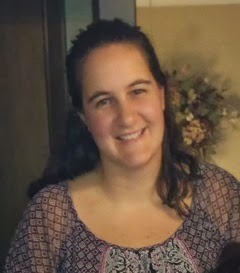 Angela Jones
Angela JonesI have always been a competent teacher. I worked hard to teach the curriculum. In my free time, I corrected a lot of papers. I was happy with the progress my kids made each year.
And then this all changed after I read The Book Whisperer by Donalyn Miller. I remember finishing the book and my first thought was that I wish I could go back and reteach all of the kids I had had in my class over the years. I felt guilty. It was a defining moment in my career. Yes, as teachers we have a curriculum to teach, but we have the power and the responsibility to do so much more. So much of this power comes in the form of books. Sharing the right books could make my students better people- more compassionate, more confident, more accepting. But how could I get my students to develop an intrinsic motivation to read? Donalyn Miller spelled it out clearly. We had to talk about books, and then talk about them some more. Kids needed to see that I made reading a priority. We began to celebrate independent reading with Friday Book Commercials. The excitement was contagious as students began sharing what they were reading through book blurbs or reviews or through creating Animoto book trailers. I was reading great books that I could recommend to them. The deep conversations continued to book clubs. And before I knew it, we had a full-fledged reading community.
With the Common Core knocking on our door, and all of the demands we have as teachers, I have felt this ideal slipping this year. There’s not enough time in the day. In writing this blog post, I stopped to catch my breath and reflect, and thank god I did. I remember that feeling of guilt I mentioned earlier and I never want to feel that way again. We are lucky as teachers that we always have tomorrow to try it again. So tomorrow, I will gather my fifth graders on our carpet, and we are just going to talk...about books.
Thank you Angela for sharing about your journey! And thank you for catching your breath and making time for what's so vitally important: books.
Published on March 11, 2014 05:30
March 10, 2014
Monday Musings
In case you didn't get it from Friday's post, the writer of the house is in a bit of a funk. So she curled up in her reading chair and settled in with some old friends, including Ray Bradbury. A person simply can't read
Zen in the Art of Writing
without sitting up a little taller. These words read Sunday night lit the fuse for Monday's work:
"The history of each story, then, should read almost like a weather report: Hot today, cool tomorrow. This afternoon, burn down the house. Tomorrow, pour cold critical water upon the simmering coals. Time enough to think and cut and rewrite tomorrow. But today -- explode -- fly apart--disintegrate! The other six or seven drafts are going to be pure torture. So why not enjoy the first draft*, in the hope that your joy will seek and find others in the world who, reading your story, will catch fire, too?"
*my emphasis, 'cause a certain writer really, really needed to hear this right now.
"The history of each story, then, should read almost like a weather report: Hot today, cool tomorrow. This afternoon, burn down the house. Tomorrow, pour cold critical water upon the simmering coals. Time enough to think and cut and rewrite tomorrow. But today -- explode -- fly apart--disintegrate! The other six or seven drafts are going to be pure torture. So why not enjoy the first draft*, in the hope that your joy will seek and find others in the world who, reading your story, will catch fire, too?"
*my emphasis, 'cause a certain writer really, really needed to hear this right now.
Published on March 10, 2014 05:30
March 7, 2014
Friend Friday
One of my best friends says it's about time I write a post inspired by him.

Every single morning and afternoon, I clip a leash on Winston the Wonder Dog and we stroll the neighborhood. Mornings are our long walks: that's when I mentally solve world problems and writing problems. Afternoon constitutionals are for sniffing every little clump of grass and hunting for pinecones (Winston, not me).
Every once in awhile, especially on our long walks, for no apparent reason, Winston will stop and come over to me, asking for a pet. Once I give it to him, he's perfectly happy and off we go. But if I don't give it, he won't keep walking.
I admire this about my dog. He sees nothing wrong in asking for a little encouragement, a little moral support, a little hug. And, once he gets it, he can get on with things.
I want to be more like that. Especially in my writing life. Crummy stuff happens all the time, doesn't it? Some of it we can't even put a name to. But some we can: an unkind review, a hopelessly tangled and mangled work in progress, the news that a beloved book is going out of print.
I've felt shame in these situations, which has led me to hold them in. But they're so sharp that they start to poke right through my flimsy writer's confidence. It's taking me years, but I've learned to follow Winston's lead and ask for a hug when I need it. And I am so lucky for dear writing friends who are willing to give those hugs -- and pep talks and sometimes much needed kicks in the heinie.
I'm curious: what do you do when the crummy stuff of the writing biz starts to weigh you down? Please share.

Every single morning and afternoon, I clip a leash on Winston the Wonder Dog and we stroll the neighborhood. Mornings are our long walks: that's when I mentally solve world problems and writing problems. Afternoon constitutionals are for sniffing every little clump of grass and hunting for pinecones (Winston, not me).
Every once in awhile, especially on our long walks, for no apparent reason, Winston will stop and come over to me, asking for a pet. Once I give it to him, he's perfectly happy and off we go. But if I don't give it, he won't keep walking.
I admire this about my dog. He sees nothing wrong in asking for a little encouragement, a little moral support, a little hug. And, once he gets it, he can get on with things.
I want to be more like that. Especially in my writing life. Crummy stuff happens all the time, doesn't it? Some of it we can't even put a name to. But some we can: an unkind review, a hopelessly tangled and mangled work in progress, the news that a beloved book is going out of print.
I've felt shame in these situations, which has led me to hold them in. But they're so sharp that they start to poke right through my flimsy writer's confidence. It's taking me years, but I've learned to follow Winston's lead and ask for a hug when I need it. And I am so lucky for dear writing friends who are willing to give those hugs -- and pep talks and sometimes much needed kicks in the heinie.
I'm curious: what do you do when the crummy stuff of the writing biz starts to weigh you down? Please share.
Published on March 07, 2014 05:30
March 6, 2014
From the Office of the Future of Reading
Please join me in welcoming today's guest blogger, Dawn Ackroyd. Dawn is a grade 3 teacher who has always been a little obsessed about reading. She loves to discuss books with kids and with adults. You can read more from Dawn at her blog and you can also follow her on twitter.
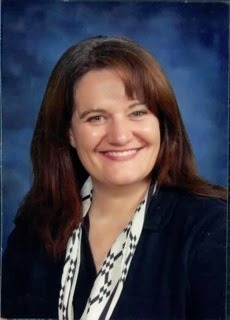
One of my favorite things about my teaching life is Grade 3 Book Club. It is an extra curricular activity in my school that about 40 kids attend. We meet once a month. We discuss books, do a craft, or play a game. At the end of book club, I do a book talk for two new books and then we vote on which book we will discuss the next month.
I used to think that it would be nice if every day was book club. The truth is, I love all the stuff in-between book club meetings just as much.
I love going to pick up the books and passing them out to students. It makes me feel like Santa Claus, ….or maybe Oprah: You get a book! And you get a book! And you get a book!
I love the buzz it creates in our school. I rarely get through my supervision duties without a student approaching me to talk about a book. They know I love books and that I love to talk about books with them.
I love having kids yell to me in the hall as they come in to let me know what chapter they're on, or ask me what chapter I'm on.
I love creating quizzes for kids to do on Edmodo and seeing the notifications roll in as they do the quiz. I love having kids post their thoughts about the book on Edmodo and having other kids respond.
I love reading favorite parts of the book to my class and having someone who wasn't reading it say, "I think I want to read that book too."
I love having kids ask me how many more days there are until our book club meeting.
I love having kids tell me at recess that they really love the book.
I love it when kids tell me how many chapters they have left, or how many they're going to read each day to finish on time.
I love it when kids come to me the day before book club and tell me they've really been trying, but they're not finished with the book, and they're wondering if they could come to book club meeting anyway (My response is always: If you've been really trying, and if you promise to finish it, sure, you can come!)
I love it when kids tell me they really don't like the book. We talk about why and I ask them if they will please still come to book club because we want to have discussions with people who don't like it as much as people who do like it.
I love perusing the shelves at United Library Services to see what is in stock, I love reading blogs and I love scouring websites to find the next perfect book.
I love coming up with ideas with the other teachers for the activity for our book club meeting.
Some people think it is a lot of work to add extra curricular activities on top of everything else in a teacher’s life. It isn’t if you love it. I really love book club!
Thank you Dawn for sharing your passion for after school book clubs! I'm betting it inspires other teachers to start clubs at their schools, too.
Published on March 06, 2014 05:30
March 5, 2014
Wednesday Wisdom
Cleaning out my office and came upon some notes from an SCBWI conference, taken long, long ago. But look at this gem from the late Paula Danziger:
"Be traveler, not a tourist."
Great advice for living AND writing!
"Be traveler, not a tourist."
Great advice for living AND writing!
Published on March 05, 2014 05:30
March 4, 2014
From the Office of the Future of Reading
Please help me welcome today's guest blogger, Michelle Cooper. Michelle, a librarian at Henderson Middle School in Henderson, Texas, is passionate about helping young people succeed by promoting information literacy, creativity, research, and problem solving. She is an Outstanding Texas Educator, Co-founder of #TXLchat, Texas Accelerated Library Leader (TALL Texan) 2013, Nerdy Book Club Blogger, guest speaker at the School Library Journal online event The Digital Shift: Reinventing Libraries, and a frequent presenter for education associations. For more information about Michelle (aka The Library Lady) visit her blog.
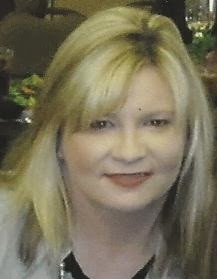
Librarian: The Best Job in the World!
The only experience better than reading a good book is sharing that book with a young person. I am fortunate enough to have that opportunity every single day. Most days students rush in and out of the library finishing up assignments, researching topics of interest and searching for a good read. One day, I noticed a change. Students began getting busier and busier. I saw them check out books less often. Students told me repeatedly, “Mrs. Cooper, I do not have time to come to the library!” Listening to them tell me why they could not spend time reading made my heart hurt. I knew something must be done. So, I decided to bring the library to the students.
 Book Fairy
Book Fairy
On Fridays, at lunch, I dress up in an outlandish costume and push a cart of books to the cafeteria. I check the books out using the library app we have at Henderson ISD. I decided to dress up, so the students would not be able to miss me in the busy cafeteria. Dressing up for me really has two purposes. My costumes make everyone laugh and spread cheer. Secondly, it is a conversation starter with the students. I love getting to know our young people and helping them with their studies. The cafeteria is a relaxed social setting, and the students feel free to share all their great ideas and dreams with me. When students need academic help, they now see the librarian as their first resource. In addition to all the fun I have had, book circulation increased nineteen percent as a result of bringing books to the students.
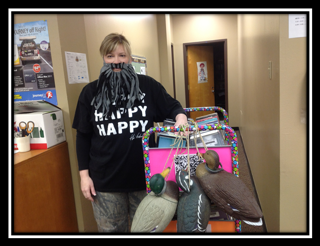 Duck Dynasty
Duck Dynasty
I became a teacher and a librarian because I truly want to make a difference in the lives of our students. I am passionate about helping young people succeed. The students are the reason I love my job. They have great ideas to share, and I learn so much from them. I could not imagine having a different occupation. I am blessed to be a librarian at Henderson ISD. 'stache Yourself a Good Book
'stache Yourself a Good Book
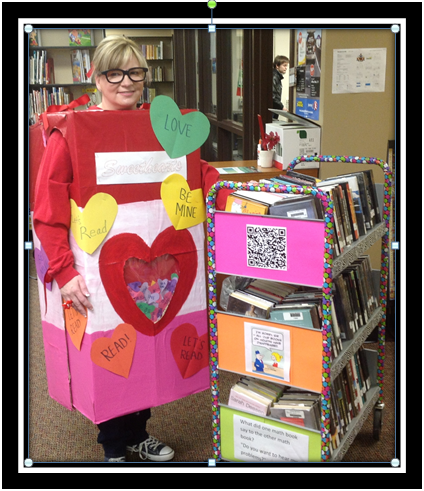 Valentines
Valentines
Thank you Michelle for focusing your passion for sharing books with students in such a creative way!

Librarian: The Best Job in the World!
The only experience better than reading a good book is sharing that book with a young person. I am fortunate enough to have that opportunity every single day. Most days students rush in and out of the library finishing up assignments, researching topics of interest and searching for a good read. One day, I noticed a change. Students began getting busier and busier. I saw them check out books less often. Students told me repeatedly, “Mrs. Cooper, I do not have time to come to the library!” Listening to them tell me why they could not spend time reading made my heart hurt. I knew something must be done. So, I decided to bring the library to the students.
 Book Fairy
Book FairyOn Fridays, at lunch, I dress up in an outlandish costume and push a cart of books to the cafeteria. I check the books out using the library app we have at Henderson ISD. I decided to dress up, so the students would not be able to miss me in the busy cafeteria. Dressing up for me really has two purposes. My costumes make everyone laugh and spread cheer. Secondly, it is a conversation starter with the students. I love getting to know our young people and helping them with their studies. The cafeteria is a relaxed social setting, and the students feel free to share all their great ideas and dreams with me. When students need academic help, they now see the librarian as their first resource. In addition to all the fun I have had, book circulation increased nineteen percent as a result of bringing books to the students.
 Duck Dynasty
Duck DynastyI became a teacher and a librarian because I truly want to make a difference in the lives of our students. I am passionate about helping young people succeed. The students are the reason I love my job. They have great ideas to share, and I learn so much from them. I could not imagine having a different occupation. I am blessed to be a librarian at Henderson ISD.
 'stache Yourself a Good Book
'stache Yourself a Good Book
 Valentines
ValentinesThank you Michelle for focusing your passion for sharing books with students in such a creative way!
Published on March 04, 2014 05:30
February 28, 2014
Friend Friday
If there is a sweeter, kinder person in the world of children's literature than Cindy Lord, I haven't met them yet. Who else would adopt a hamster after writing a book about one? A hamster that has led to two bunnies and a fish and a volunteer job at a local shelter and a forthcoming series called Shelter Pet Squad (Aug. 2014)! But today's post is about Cindy's latest book, Half a Chance. Let me turn this over to Cindy so she can tell us all about it.
 Cynthia Lord
Cynthia Lord
Half A Chance
My books always begin from real things. Half a Chancecame from growing up on a lake in New Hampshire and having an aunt with Alzheimer’s.
As a child, I loved visiting my aunt who lived down the road from us. Aunt Anne was a third-grade teacher, and she had lots of books. She also had encyclopedias that she allowed me to borrow, one volume at a time.
I remember walking home, my flip-flops slapping the road, carrying kids’ books and Volume K under my arm.
 As a child, this was my front yardAbout 20 years ago, Aunt Anne started forgetting. At first it was little things. Then we realized this was more than ordinary forgetfulness. I’ve watched this smart, capable, funny woman lose whole parts of herself.
As a child, this was my front yardAbout 20 years ago, Aunt Anne started forgetting. At first it was little things. Then we realized this was more than ordinary forgetfulness. I’ve watched this smart, capable, funny woman lose whole parts of herself.
For a long time, we kept her connected to her past with photos. We’d go through a stack of photos, telling stories. Times change, places change, and we change, but a photo holds time still. In a photo we’re always the person we were in that split second.
One day Aunt Anne said, “Cindy, I won’t remember this. You must remember for both of us.” So I’ve become the keeper of our shared history.

In Half A Chance, Lucy has moved with her parents to a lake house in New Hampshire. Her dad is a famous photographer, and he is judging a kids’ scavenger-hunt photography contest. Lucy wants to enter, but she knows he won’t judge her fairly. So she and Nate, the boy next door, do the contest together. They put his name on the entry. One day, Lucy takes a photo of Nate’s grandmother in a moment when the older woman is confused. When Lucy sees the photo, she knows she has captured a powerful image. An image that is art.
I scrolled through my photos of Grandma Lilah on her porch. I smiled at her pretending to be Doris Day. But in the last photo, Grandma Lilah was sitting up very straight, holding the teacup. That photo was all about her eyes. Full of panic, they seized me and wouldn’t let me go. I could hear Dad in my mind gasping with me at what I had captured. A true and terrible moment.
The underlying questions of a book are important to me. I pick questions I don’t know the answers to—sometimes that even scare me.
Some questions I asked myself about Half A Chance:
What makes us who we are?What if those things change in big ways?When we take a photo of someone else, who owns that photo? Is it us? Do we owe something to the person whose image we’ve captured? Does that change if a photo is art?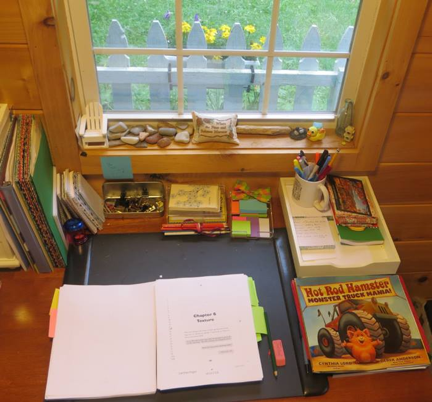 My desk
My desk
In Half A Chance it says, “Even in the midst of horrible things, there are little bits of wonder and all of it’s true.” That reminds me there is beauty everywhere, even in unlikely places.
And often, it’s art that lets us see it.
Cindy, thank you so much. You write such beautiful and true books and I am so grateful for that. And grateful that you made time to visit my blog today!
 Cynthia Lord
Cynthia LordHalf A Chance
My books always begin from real things. Half a Chancecame from growing up on a lake in New Hampshire and having an aunt with Alzheimer’s.
As a child, I loved visiting my aunt who lived down the road from us. Aunt Anne was a third-grade teacher, and she had lots of books. She also had encyclopedias that she allowed me to borrow, one volume at a time.
I remember walking home, my flip-flops slapping the road, carrying kids’ books and Volume K under my arm.
 As a child, this was my front yardAbout 20 years ago, Aunt Anne started forgetting. At first it was little things. Then we realized this was more than ordinary forgetfulness. I’ve watched this smart, capable, funny woman lose whole parts of herself.
As a child, this was my front yardAbout 20 years ago, Aunt Anne started forgetting. At first it was little things. Then we realized this was more than ordinary forgetfulness. I’ve watched this smart, capable, funny woman lose whole parts of herself. For a long time, we kept her connected to her past with photos. We’d go through a stack of photos, telling stories. Times change, places change, and we change, but a photo holds time still. In a photo we’re always the person we were in that split second.
One day Aunt Anne said, “Cindy, I won’t remember this. You must remember for both of us.” So I’ve become the keeper of our shared history.

In Half A Chance, Lucy has moved with her parents to a lake house in New Hampshire. Her dad is a famous photographer, and he is judging a kids’ scavenger-hunt photography contest. Lucy wants to enter, but she knows he won’t judge her fairly. So she and Nate, the boy next door, do the contest together. They put his name on the entry. One day, Lucy takes a photo of Nate’s grandmother in a moment when the older woman is confused. When Lucy sees the photo, she knows she has captured a powerful image. An image that is art.
I scrolled through my photos of Grandma Lilah on her porch. I smiled at her pretending to be Doris Day. But in the last photo, Grandma Lilah was sitting up very straight, holding the teacup. That photo was all about her eyes. Full of panic, they seized me and wouldn’t let me go. I could hear Dad in my mind gasping with me at what I had captured. A true and terrible moment.
The underlying questions of a book are important to me. I pick questions I don’t know the answers to—sometimes that even scare me.
Some questions I asked myself about Half A Chance:
What makes us who we are?What if those things change in big ways?When we take a photo of someone else, who owns that photo? Is it us? Do we owe something to the person whose image we’ve captured? Does that change if a photo is art?
 My desk
My deskIn Half A Chance it says, “Even in the midst of horrible things, there are little bits of wonder and all of it’s true.” That reminds me there is beauty everywhere, even in unlikely places.
And often, it’s art that lets us see it.
Cindy, thank you so much. You write such beautiful and true books and I am so grateful for that. And grateful that you made time to visit my blog today!
Published on February 28, 2014 05:30
February 27, 2014
From the Office of the Future of Reading
Please join me in welcoming today's guest blogger, Linda Baie. Linda is a long time teacher of middle school students at a K-8 independent school for the gifted in Denver, Colorado. She has recently moved from the classroom into the part-time position of literacy coach and works with both students and teachers. She has a son and son-in-law, a daughter and daughter-in-law, one grandson and two granddaughters. Passions are reading, writing and being outdoors. For a long while, Linda rode horses, but has been lately too busy to take care of a horse so had to give it up. Maybe someday she will return. She also blogs and, sometimes, tweets.
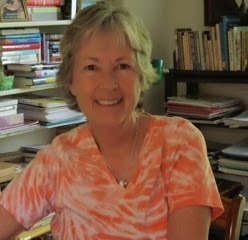 Linda Baie
Linda Baie
The school where I work is a progressive school where each child chooses an individual topic to study and the work done within that topic is created by both the student and the teacher. Most curriculum areas fall into this, but students also enjoy other areas of study, including separate language arts learning. Reading expectations vary, but in the Advanced School--grades 6, 7, 8--students are expected to read at least one book each week, about 200 pages, and even that expectation can change depending on differing factors like student ability and the book’s level of complexity. This year I began professional book studies with each group of teachers in the school, primary, intermediate and advanced. The Advanced School teachers expressed interest in reaching students at a deeper level in their reading and I suggested that we read and discuss Penny Kittle’s Book Love-Developing Depth, Stamina, and Passion in Adolescent Readers. We have read one chapter each month, discussing the ideas presented and how to integrate them into unique schedules. Their classes do not fit a departmentalized schedule, but have long work times for students where students choose what assignments to work on. For example, there may be small group meetings about writing while others are researching, and still others are creating art, doing math, etc. These teachers shared some questions to address about reading: How can we increase the enthusiasm for reading? How can we insure each student has a wealth of ideas for books to love and books that will challenge? What can we do in our already busy schedules that doesn’t take too much time, yet still show students that reading, and reading a lot is important learning?
Penny Kittle, on page 33 of Book Love, writes “two things that really matter if we want to move kids from where they are to where we want them to be: the to-read-next list, so each reader has a plan; and reading conferences that put the teacher one-on-one with a student, asking where she is in her independent reading and what she plans to read next.” From the beginning of this school year, each teacher has put different practices in place that differ from last year. One teacher started a blog, and has all students blogging too. First, they blogged only to post book reviews. They also posted a TBR (to be read) list. The teacher also began doing book talks each Friday, and soon began asking students to participate. I’ve given a few book talks with the classes, and they’ve had guests visit to talk about favorite books. Time talking about books both in class and online has meant much to the improvement in reading and enthusiasm about reading. We believe the student choices are more considered, less random.
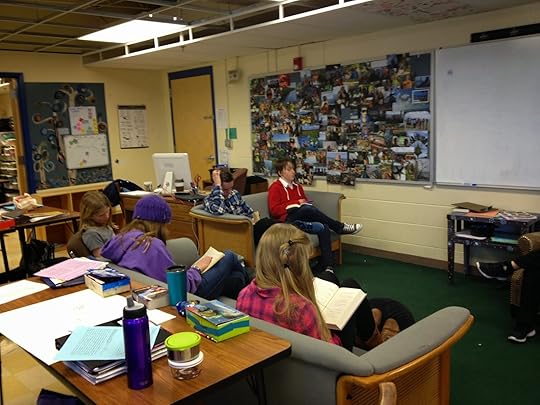 Lost in a good book
Lost in a good book
Another teacher wanted to be sure the students weren’t leaving reading their books until late at night or doing ‘binge’ reading on the weekend in order to finish. She also does book talks, but has added a time for silent reading. Every day, after lunch, student come in, grab their books and read for fifteen minutes. After a week or so of grumbling and pushing the students to be quicker to start, she says it’s become a habit. It helps students really get “into” the books chosen, helps them to calm down after lunch and recess (yes, even our oldest kids go outside after lunch), and helps the transition to the later work time. They can choose to continue reading or stop to work on another project. This also gives the teacher time to confer with individuals.
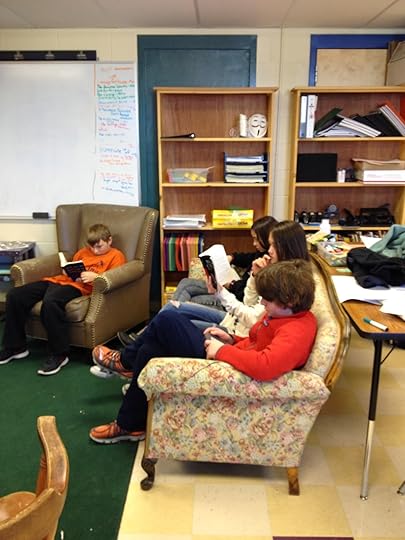 Just another page. . .please!
Just another page. . .please!
The third teacher has begun genre studies so that he can share and discuss the distinct characteristics of genres. Students are free to choose within the genre studied, so a wealth of book titles is added to their knowledge along with the close examination of a genre, and then some figuring out that there are still differences. One book labeled science fiction may not fit all the characteristics that the class has learned, but the student reading it is able to add to the discussion because he or she sees other attributes in a particular book. These are the highlights of the deliberate changes made. Some positive results are shared above, and the overall result is that students are more enthusiastic, more likely to talk about choices and realize that choosing well means a very good read. All of us believe that deliberate actions by the teachers that center on independent reading have improved all students’ enthusiasm and book knowledge. Increased conversations about books and reading help students become more thoughtful when they read and when they reflect upon their reading. Thanks to Kirby for inviting me to visit. I love sharing a part of what’s going on in reading at my school.
Thank you Linda for sharing your insight and experiences with us all. The energy for reading at your school glows from your words!
 Linda Baie
Linda BaieThe school where I work is a progressive school where each child chooses an individual topic to study and the work done within that topic is created by both the student and the teacher. Most curriculum areas fall into this, but students also enjoy other areas of study, including separate language arts learning. Reading expectations vary, but in the Advanced School--grades 6, 7, 8--students are expected to read at least one book each week, about 200 pages, and even that expectation can change depending on differing factors like student ability and the book’s level of complexity. This year I began professional book studies with each group of teachers in the school, primary, intermediate and advanced. The Advanced School teachers expressed interest in reaching students at a deeper level in their reading and I suggested that we read and discuss Penny Kittle’s Book Love-Developing Depth, Stamina, and Passion in Adolescent Readers. We have read one chapter each month, discussing the ideas presented and how to integrate them into unique schedules. Their classes do not fit a departmentalized schedule, but have long work times for students where students choose what assignments to work on. For example, there may be small group meetings about writing while others are researching, and still others are creating art, doing math, etc. These teachers shared some questions to address about reading: How can we increase the enthusiasm for reading? How can we insure each student has a wealth of ideas for books to love and books that will challenge? What can we do in our already busy schedules that doesn’t take too much time, yet still show students that reading, and reading a lot is important learning?
Penny Kittle, on page 33 of Book Love, writes “two things that really matter if we want to move kids from where they are to where we want them to be: the to-read-next list, so each reader has a plan; and reading conferences that put the teacher one-on-one with a student, asking where she is in her independent reading and what she plans to read next.” From the beginning of this school year, each teacher has put different practices in place that differ from last year. One teacher started a blog, and has all students blogging too. First, they blogged only to post book reviews. They also posted a TBR (to be read) list. The teacher also began doing book talks each Friday, and soon began asking students to participate. I’ve given a few book talks with the classes, and they’ve had guests visit to talk about favorite books. Time talking about books both in class and online has meant much to the improvement in reading and enthusiasm about reading. We believe the student choices are more considered, less random.
 Lost in a good book
Lost in a good bookAnother teacher wanted to be sure the students weren’t leaving reading their books until late at night or doing ‘binge’ reading on the weekend in order to finish. She also does book talks, but has added a time for silent reading. Every day, after lunch, student come in, grab their books and read for fifteen minutes. After a week or so of grumbling and pushing the students to be quicker to start, she says it’s become a habit. It helps students really get “into” the books chosen, helps them to calm down after lunch and recess (yes, even our oldest kids go outside after lunch), and helps the transition to the later work time. They can choose to continue reading or stop to work on another project. This also gives the teacher time to confer with individuals.
 Just another page. . .please!
Just another page. . .please!The third teacher has begun genre studies so that he can share and discuss the distinct characteristics of genres. Students are free to choose within the genre studied, so a wealth of book titles is added to their knowledge along with the close examination of a genre, and then some figuring out that there are still differences. One book labeled science fiction may not fit all the characteristics that the class has learned, but the student reading it is able to add to the discussion because he or she sees other attributes in a particular book. These are the highlights of the deliberate changes made. Some positive results are shared above, and the overall result is that students are more enthusiastic, more likely to talk about choices and realize that choosing well means a very good read. All of us believe that deliberate actions by the teachers that center on independent reading have improved all students’ enthusiasm and book knowledge. Increased conversations about books and reading help students become more thoughtful when they read and when they reflect upon their reading. Thanks to Kirby for inviting me to visit. I love sharing a part of what’s going on in reading at my school.
Thank you Linda for sharing your insight and experiences with us all. The energy for reading at your school glows from your words!
Published on February 27, 2014 05:30



